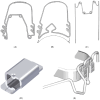Comparative Experimental Evaluation of Orthodontic Appliances for Maxillary Arch Expansion
- PMID: 39518612
- PMCID: PMC11546383
- DOI: 10.3390/jcm13216473
Comparative Experimental Evaluation of Orthodontic Appliances for Maxillary Arch Expansion
Abstract
Background/Objectives: The orthodontic treatment of posterior crossbite using appliances for gradual maxillary expansion is crucial to ensure proper transversal jaw relationships as much as occlusal functionality. The aim of this study was to analyze forces and torques generated by different appliances for maxillary expansion. Methods: Measurements were conducted for the Wilson® 3D® Quadhelix (WQH) and Wilson® 3D® Multi-Action Palatal Appliance (WPA) across various sizes and compared to the Remanium® Quadhelix (RQH). Activations were set to 8 mm for the WQH and RQH and 6 and 8 mm for the WPA. Rotations and root torque were simulated via an activation of 10° for arches. A total of eight test series were conducted. Results: The WPA displayed the highest force and torque values for all movements, far surpassing recommended guideline values (expansion 8.5->15.0 N/46.3-86.5 Nmm, rotation 3.1-6.1 N/40.7-61.4 Nmm, torque 3.9-5.1 N/22.4-29.7 Nmm), and the WQH displayed the lowest values (expansion 2.7-12.6 N/11.1-39.6 Nmm, rotation 0.1-1.7 N/23.0-32.2 Nmm, torque 0.9-2.9 N/3.4-10.5 Nmm). Appliances with the smallest transverse dimensions exhibited the highest force and torque maxima. Conclusions: This study underscores the importance of understanding biomechanical principles in orthodontics for minimizing unintended tooth movements, providing detailed insights into the force systems of appliances acting in the transverse plane, and establishing a foundation for future clinical investigations to validate these in vitro findings.
Keywords: arch expansion; orthodontic forces; posterior crossbite; quadhelix; torque.
Conflict of interest statement
The authors declare no conflict of interest.
Figures





References
-
- Bell R.A., Kiebach T.J. Posterior crossbites in children: Developmental-based diagnosis and implications to normative growth patterns. Semin. Orthod. 2014;20:77–113. doi: 10.1053/j.sodo.2014.04.002. - DOI
-
- Almaqrami B.S., Alhammadi M.S., Tang B., ALyafrusee E.S., Hua F., He H. Three-dimensional morphological and positional analysis of the temporomandibular joint in adults with posterior crossbite: A cross-sectional comparative study. J. Oral. Rehabil. 2021;48:666–677. doi: 10.1111/joor.13156. - DOI - PubMed
-
- Myllymäki E., Heikinheimo K., Suominen A., Evälahti M., Michelotti A., Svedström-Oristo A.L., Rice D.P. Longitudinal trends in temporomandibular joint disorder symptoms, the impact of malocclusion and orthodontic treatment: A 20-year prospective study. J. Oral. Rehabil. 2023;50:739–745. doi: 10.1111/joor.13471. - DOI - PubMed
LinkOut - more resources
Full Text Sources

